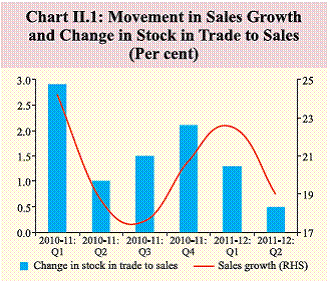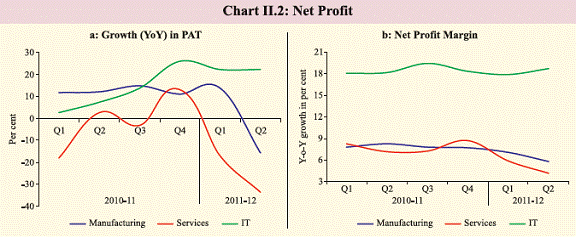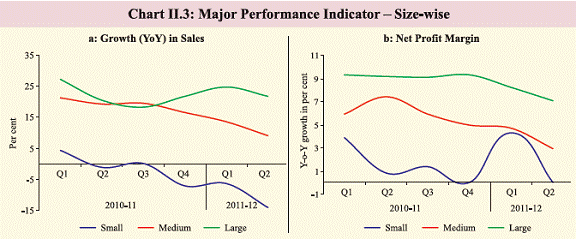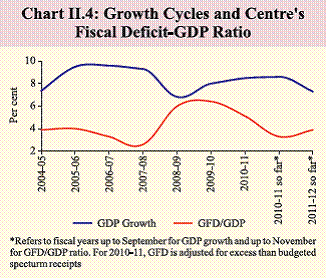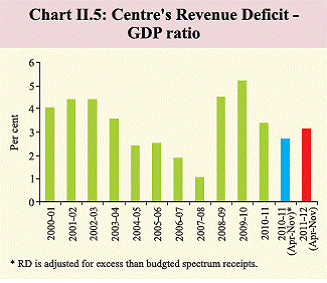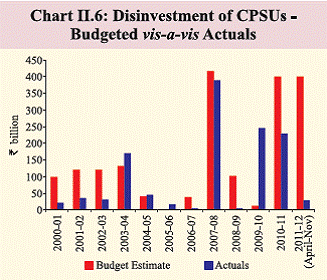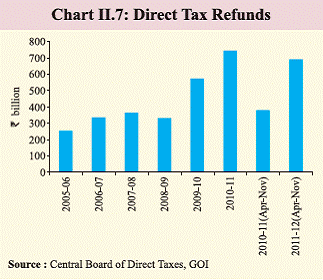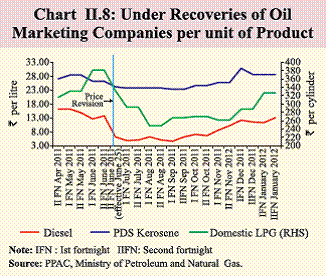II. Aggregate Demand - ਆਰਬੀਆਈ - Reserve Bank of India
II. Aggregate Demand
Aggregate demand softened as a result of dampening external and investment demand. With global uncertainties adversely impacting exports, external demand slowed. There was a rapid drying up of corporate investment pipeline in Q2 of 2011-12 which affected growth. Private consumption continues to moderate slowly, while government consumption spending is on the rise. Central government’s deficit indicators are under duress due to higher subsidies and lower tax collections in a slowing economy. Going forward, there is a need for rebalancing public spending from consumption to investment to recover growth as well as to enhance its potential rate. Falling external and investment demand may drag 2012-13 growth II.1 Softening consumption demand coupled with decelerating investment and contracting external demand led the moderation in GDP at market prices to 7.6 per cent in H1 of 2011-12 (Table II.1). Consumption softened on account of high inflation and tapering of demand in interest-rate sensitive sectors. Investment decelerated due to both monetary and nonmonetary factors. Net exports declined sharply in H1 of 2011-12, largely reflecting the slackening of global demand. II.2 Slow down in investment and weakning external demand could have unfavourable impact on growth. Estimates indicate that a one percentage point decline in gross fixed capital formation rate would shave off about 0.2 percentage point from the potential output. Growth rate cycles of the Indian and the world economy have shown increasing convergence. Estimates indicate that a one percentage point decline in the growth rate of the world economy would result in about a 0.3 percentage point decline in the growth rate of non-agricultural GDP in India.
Sharp decline in investment intentions of corporates II.3 During 2010-11, envisaged corporate investment in new projects dipped sharply by about 43 per cent in H2 from H1. It remained about the same level in Q1 of 2011-12 but again fell steeply in Q2 on a sequential basis. Project finance data of banks/financial institutions indicate a near 77 per cent decline in total outlay of projects sanctioned in Q2 of 2011-12 from the same period of the previous year (Table II.2). II.4 Industry-wise, the share of new investment planned for power and metal and metal products witnessed a sharp sequential decline in Q2 of 2011-12, while textiles and cement industries registered improvement. II.5 Based on time-phasing details of projects sanctioned institutional assistance, capital expenditure by private corporate (non-financial) sector during the year 2011-12 is likely to be lower than in the previous years. The rise in interest rates and cost of raw materials may have adversely affected the investment sentiment (Table II.3). Corporate margins slide on rising costs, slowing demand II.6 There was a moderate slackening of sales growth in Q2 of 2011-12 compared with the previous two quarters, reflecting gradual waning of demand (Table II.4). Increase in interest payment, staff cost and raw material cost led to erosion of net profits (Table II.5). Inventory accumulation, however, was lower than that during the previous quarter as well as corresponding quarter of the previous year (Chart II.1).
II.7 IT companies bucked the trend and registered 22.2 per cent growth in net profits (Chart II.2). Also, while large companies registered strong growth in sales and compression only of margins, small companies suffered on both counts (Chart II.3). II.8 Available early results of 85 companies for Q3 of 2011-12 (which account for only 10 per cent of sales of all non-government non-financial listed companies), suggest that sales growth remained healthy and growth in operating profits (PBDIT) and net profits (PAT) were higher as compared with Q2 of 2011-12.
Fiscal space constrained as structural deficit rises on top of cyclical pressures II.9 The Central government’s key deficit indicators widened during 2011-12 (April- November), reflecting an interplay of cyclical and structural factors. The growth moderation has impacted total tax revenues, more so because direct tax collections have suffered on account of significant quantum of tax refunds and lower corporate profits. Impact of growth cycles of the economy has been visible over the years with downturns raising deficits and recoveries reducing them (Chart II.4). II.10 Fiscal imbalances have continued to reflect structural rigidities on the expenditure side on account of inability of the government to control subsidy expenditures despite budgeting a decline in such expenditures. Consequently, the Centre could not meet its mid-year FRBM benchmarks. The benchmarks were for revenue and fiscal deficits at not more than 45 per cent of budget estimates and nondebt receipts at not less than 40 per cent of budget estimates.
Increasing revenue account imbalance causes concern II.11 Mounting revenue deficit (RD) is putting fiscal position under strain and impacting the Government’s ability for capital spending. The Centre had budgeted no change in RD-GDP ratio (3.4 per cent) for 2011-12 recognising that the one-off receipts in respect of non-tax revenues from spectrum auctions a year ago would not be available. Accordingly, it had projected sharp deceleration in growth rates for both revenue receipts and revenue expenditure. However, revenue expenditure decelerated only marginally while revenue receipts contracted. Consequently, revenue deficit during the first eight months turned out to be 91.3 per cent of the annual budgeted target for 2011-12. Thus, RD-GDP ratio was also higher during 2011-12 (April-November) from that in the corresponding period of the previous year even after adjustment is made for excess than budgeted spectrum receipts (Chart II.5). Although the ratio of RD to gross fiscal deficit (GFD), an important benchmark for assessment of the quality of fiscal consolidation, worked out lower at 79.5 during 2011-12 (April-November) as compared with adjusted ratio of 81.8 percent during 2010- 11 (April-November), it remained higher than the budgeted ratio (73.9 per cent) for 2011-12 as a whole. This indicates that a large portion of borrowings are used to finance the revenue deficit, thereby reducing the availability of resources to undertake capital outlays. This could have adverse implications for India’s potential growth.
II.12 There has been a shortfall in total nondebt receipts in 2011-12 (April-November) with growth in tax revenues lagging even the conservatively projected growth in the Union Budget. The government appears to have fallen short of its budgeted targets for disinvestment of Central Public Sector Undertakings (CPSUs) (Chart II.6). Also, expenditure is likely to surpass the budgeted level, as evident from additional requisitions made in the second supplementary demands for grants in November 2011. Current assessment indicates that fiscal deficit may turn out to be higher than the budget estimates of 2011-12 by around one percentage point of GDP. In this context, it may be noted that fiscal slippage could be higher in the event of further economic slowdown. The Centre’s mid-year analysis of its fiscal conditions recognised that it would be challenging to meet the deficit targets for 2011-12.
II.13 Prospectively, improvement in fiscal situation in 2012-13 is not only contingent upon the growth performance but also on the progress in implementation of tax and expenditure reforms. A delay in enactment of the Direct Tax Code (DTC) Bill (presently under consideration of the Standing Committee on Finance) may affect its scheduled introduction from April 1, 2012. In respect of Goods and Services Tax (GST), while the Bill to amend the Constitution for introducing this tax was tabled in March 2011, the draft GST legislation requires consensus on a number of issues involving both the Centre as well as State governments. On the expenditure front, the government needs to move towards deregulation of pricing of diesel for controlling its expenditure on petroleum subsidies. Unless fiscal reforms are expedited, the Centre could miss the rolling target of fiscal deficit at 4.1 per cent of GDP for 2012-13 as set out in the Union Budget 2011-12. Tax revenue may fall short of 2011-12 budgeted level, further buoyancy depends on growth and reforms II.14 Growth in tax revenue decelerated during 2011-12 (April-November), affected by significant direct tax refunds, reduction in duties in respect of petroleum products and moderation in economic growth. Sharp deceleration was observed in growth of corporation tax revenues on account of refunds as well as slowdown in industrial activity. Significantly higher direct tax refunds during the current year so far indicates that fiscal correction witnessed during 2010-11 could have been, to some extent, contributed by excess collections which have been refunded during the current year so far (Chart II.7). Overall indirect tax growth during the current year so far remained in line with the budgeted growth.
Need to step up public investment as lower corporate investment pipeline may delay recovery II.15 Given the deceleration in private investment intention, drying up of public investment may further delay recovery of economic growth. During 2011-12 (April- November), the rate of growth of plan expenditure (both revenue and capital) was slower than the budgeted growth for the full year. The growth rate of capital outlays was lower than in the corresponding period a year ago. This was mainly due to lower plan expenditures in various Ministries/Departments like rural development, agriculture, health and family welfare and drinking water supply. Subsidies exerting unsustainable pressure, need for budgetary solution to enhanced commitments II.16 The deceleration in aggregate expenditure growth in the current fiscal year so far was mainly driven by lower plan expenditure growth. Non-plan expenditure, on the other hand, recorded a higher growth attributable to higher expenditure on major subsidies and interest payments. II.17 The per unit under-recovery on sale of diesel and PDS kerosene, which had moderated in the second half of December 2011, increased in January 2012, in line with the hardening of global crude oil prices and weakening of the rupee (Chart II.8). By current indications, the under-recoveries of oil marketing companies (OMCs) for sale of administered petroleum products are projected at around `1,323 billion for 2011-12. The Centre has already exhausted its budgetary provision for petroleum subsidies and has indicated additional provisions (`300 billion) in the second supplementary demand for grants presented in November 2011. It is estimated that the higher expenditure on petroleum subsidy could drive up the fiscal deficit by around 0.8 percentage points of GDP for 2011-12. The government will face additional pressures on account of food subsidies when the proposed Food Security Bill is enacted and implemented. Consequently, the government needs to control its expenditure on petroleum subsidies. This would require further deregulation of the prices of administered petroleum products. Amended FRBMs of States reflect resumption of rule-based fiscal consolidation II.18 The consolidated revenue account of the States is budgeted to record surplus in 2011-12, indicative of the return to the fiscal consolidation path as envisaged by the Thirteenth Finance Commission. The improvement in the revenue account, which is largely on account of a compression in the revenue expenditure, is expected to not only provide the necessary resources to increase capital outlay but also to enable a reduction in the GFD to GDP ratio that is budgeted to fall by 0.4 percentage point. The States were required to amend their Fiscal Responsibility and Budget Management Acts (FRBMs) mapping out paths for elimination of revenue deficit and graduated reductions in fiscal deficit to 3 per cent of their Gross State Domestic Product (GSDP), latest by 2014-15, in order to be eligible for State-specific grants and interest relief on NSSF loans. Majority of the State governments have already amended their FRBMs during 2011-12.
II.19 Notwithstanding the committed stance for reduction in budgetary imbalances, the growing contingent liabilities of State governments, particularly those relating to the exposure of State Power Utilities have emerged as an area of concern in State finances. The High Level Panel (HLP) on Financial Position of Distribution Utilities (Chairman: Shri V.K. Shunglu) in its report recently submitted to the Planning Commission has noted that the accumulated losses of power distribution companies (discoms) during 2005-10 amounted to `820 billion. Over 70 per cent of the losses have been financed by public sector banks and 42 per cent of these loans are backed by State government guarantees. In case of default, the invocation of the State guarantees could have a significant impact on State finances as the cushion available in the form of States’ guarantee redemption funds remains inadequate (`40 billion). Tighter adherence to fiscal rules necessary as increasing dependence on market borrowings is worrisome II.20 In the current fiscal year so far, the Centre financed its GFD and withdrawals in its public account mainly through market borrowings in the wake of lower net accretion under National Small Savings Fund. There was also recourse to Ways and Means Advances, thereby leading to monetisation of deficit. Further, there was draw-down of cash balances and disinvestment of surplus cash by the Centre (Table II.6). The Centre has twice revised its market borrowings target upwards for the second half of 2011-12, thereby raising the gross market borrowings through dated securities for 2011-12 by 22.3 per cent above the budgeted amount. The centre has also taken a significant recourse to financing deficit through T-bills. Higher government borrowing pushes up yields and also crowds out the domestic funding available for private investment. Reforms required for a turnaround in 2012-13 II.21 Amidst general macro-economic weakness, with a widening current account deficit, larger fiscal spending could further affect growth and stability in the economy. There is need for cutting government’s consumption expenditure and stepping up its capital spending in order to lift both the current and future growth. This will help the economy to get back to higher potential growth that it had realised in the pre-crisis period. II.22 With inflation projected to decline in Q4 of 2011-12 and monetary rate cycle peaking, a revival of business optimism could occur, especially if fiscal imbalances are contained so as to provide more room on monetary side. For 2012-13, while tax revenues could be affected by risks associated with global uncertainty and its impact on domestic growth scenario, the attainment of Union Budget 2011-12’s rolling target of gross tax revenue-GDP ratio of 10.8 per cent for 2012-13 critically depends on timely implementation of DTC. It is expected that DTC system would improve compliance levels as rates of corporation tax and surcharge are reduced and tax base is widened. While greater uncertainty surrounds the introduction of GST, a consensus needs to be built for the successful rollout of GST in order to further improve compliance and enable overall tax buoyancy to return to pre-crisis levels. In the short-run, reliance on temporary measures such as disinvestment cannot be avoided. However, plans in this regard would need to be calibrated to market conditions, so that revenue proceeds can be well spaced. Furthermore, reforms on the revenue side need to be backed by steps to contain subsidies so that they can be funded out of the budget on a sustainable basis. * Despite well-known limitations, expenditure-side GDP data are being used as proxies for components of Aggregate Demand. |
||||||||||||||||||||||||||||||||||||||||||||||||||||||||||||||||||||||||||||||||||||||||||||||||||||||||||||||||||||||||||||||||||||||||||||||||||||||||||||||||||||||||||||||||||||||||||||||||||||||||||||||||||||||||||||||||||||||||||||||||||||||||||||||||||||||||||||||||||||||||||||||||||||||||||||||||||||||||||||||||||||||||||||||||||||||||||||||||||||||||||||||||||||||||||||||||||||||||||||||||||||||||||||||||||













